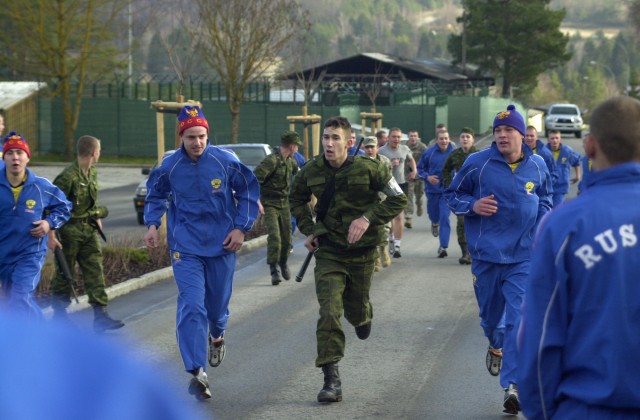
HOHENFELS TRAINING AREA, Germany (Dec. 12, 2007) -- At the height of the Cold War, the idea of the armies of the U.S. and the Soviet Union training together, discussing operational tactics, or even just fraternizing on a personal level, would have seemed absurd. But today it's happening here, as U.S. Army Europe and Russian troops come together during the 2007 "Torgau" exercise.
Just days before the 16th anniversary of the dissolution of the Soviet Union, Soldiers from the two nations are well into the two-week exercise, an event that is a mix of combined field and command post training and a chance for people and cultures to get better acquainted.
The exercise began with Russian and American Soldiers training together on weapons procedures and vehicle operations in preparation for situational training exercises in the second week of Torgau. But before they began the more intensive warfighting training required by the STX, the two armies enjoyed a "cultural day" of recreation and relaxation that included a basketball tournament, a strength contest, and a "run and shoot" competition.
The basketball tournament pitted teams comprised of a mix of Soldiers from both armies in a daylong competition. The strength contest pushed entrants in weightlifting and pull-up events designed to determine which Soldier could display the greatest physical power. For the run and shoot competition contestants had to run two miles to a range, fire a series of live rounds with M16 rifles, and then run back to the starting point.
Russian Lt. Salim Pashtov, the first contestant to finish the run and shoot event, proclaimed it a great day for him and for both armies. "I am very proud," he said.
The cultural activities also made it clear the two forces have much in common. Lt. Col. Michael Borg of USAREUR's Joint Multi-National Readiness Center, the senior trainer for the Torgau exercise, said it was evident the two armies are not that different. "Both sides have been willing and eager to participate," Borg said. "Cultural day was an absolute success."
"I think it went very well," added JMRC's Maj. Paul Weyrauch, assistant senior exercise trainer for Torgau. He said the cultural day was really about using healthy competition to build bonds between the two groups that would pay dividends in the latter half of the exercise and beyond.
"It achieved what we wanted it to achieve," the major said.
Weyrauch also said the Americans and Russians were able to meet the training objectives for the first week of the exercise without any major setbacks. "Last week was a great week by design," he said.
Weyrauch and Borg said they were eager to test the bonds forged on cultural day at the STX lanes, where the two armies would be faced with realistic battlefield scenarios that would determine what level of interoperability the two had achieved up to that point.
"Team building -- that's the one thing I would want to get out of this (exercise)," Borg said.
"Our hope is that (the Russians) have a better understanding of how we operate," added Weyrauch.
With those goals in mind, Torgau 2007 could well be a benchmark of the post-Cold War era that furthers a cooperative alliance between Russia and the U.S. and enhances the warfighting capacity of both nations.
"We need every man in the fight," Borg said.

Social Sharing